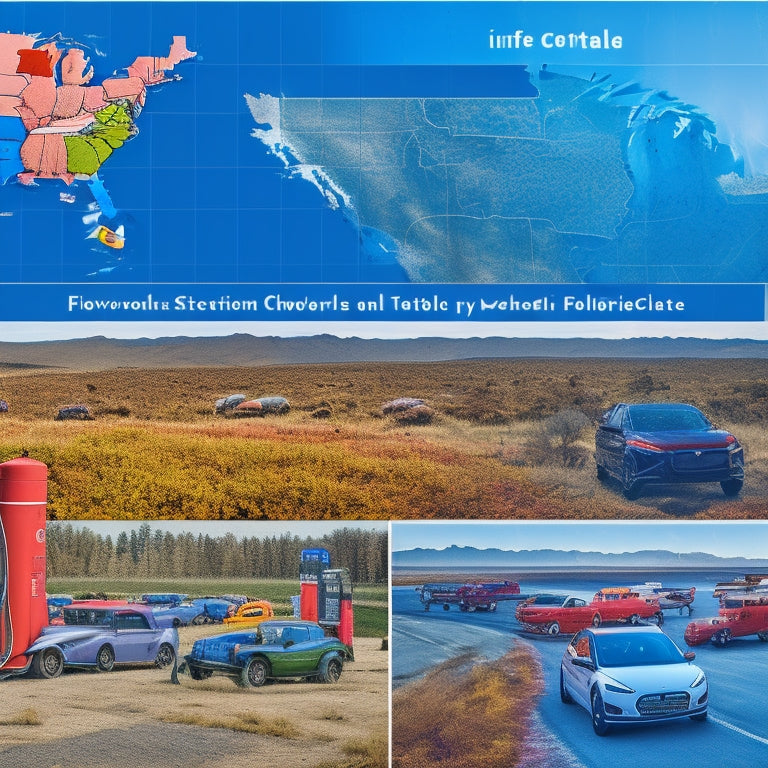
Political Divide Shapes Electric Vehicle Adoption Trends
Share
Political ideology plays a key role in influencing electric vehicle (EV) adoption trends, with Democratic voters showing a higher likelihood of adopting EVs due to environmental concerns. Regional disparities, such as urban-rural differences, and economic factors like income and commute distances also play a significant role in shaping adoption patterns. Access to charging infrastructure, especially in urban areas, is crucial. Vehicle preferences, such as the lack of EV options for full-size trucks and SUVs, impede adoption in rural areas. Understanding these factors is crucial for policymakers and stakeholders. By delving into the intricate interplay among these factors, a detailed picture of EV adoption emerges, uncovering opportunities for growth and development.
Key Takeaways
• Political ideology significantly influences Electric Vehicle (EV) adoption, with Democratic voters more likely to adopt EVs than Republican voters.
• EV adoption rates vary across geographic regions, with urban areas having higher adoption rates due to better charging infrastructure and shorter commute distances.
• Economic factors, including commute distance, housing prices, and population density, also impact EV adoption patterns, with higher-income households more likely to adopt EVs.
• The lack of EV options for full-size trucks and SUVs limits adoption, particularly in rural areas, where trucks are more popular.
• Understanding the interplay between political ideology, economic, and geographic factors is essential for policymakers and industry stakeholders to promote widespread EV adoption.
Factors Shaping EV Adoption Patterns
Driven by a complex interplay of factors, electric vehicle (EV) adoption patterns are shaped by a multitude of influences, including political ideology, income levels, population density, and access to charging infrastructure. Societal perceptions play a significant role, with environmental impact being a key consideration for many adopters.
Research has shown that political ideology remains an important factor in EV adoption, even when controlling for income and population density. Additionally, access to charging infrastructure is a critical component, with EV outlets concentrated in urban regions.
Understanding these factors is essential for policymakers and industry stakeholders seeking to promote widespread EV adoption. By recognizing the interplay between these factors, we can better navigate the complexities of EV adoption and work towards a more sustainable transportation future.
Regional Disparities in EV Uptake
Significantly, regional disparities in electric vehicle (EV) uptake are pronounced, with adoption rates varying substantially across different geographic regions, influenced by factors such as population density, commute distances, and access to charging infrastructure.
Urban areas tend to have higher EV adoption rates compared to rural areas, largely due to better access to charging infrastructure and shorter commute distances. Income levels also play a role, with higher-income households more likely to adopt EVs.
Importantly, rural areas face unique challenges, including limited access to charging infrastructure, which hinders EV adoption. These regional disparities highlight the need for targeted policies and investments to promote EV adoption across diverse geographic regions.
Economic and Geographic Influences
Geographically, economic factors greatly influence electric vehicle adoption patterns. Varying commute distances, housing prices, and population densities shape household decisions to purchase electric vehicles. Commute distance plays a significant role, with shorter commutes making EVs a more viable option. Housing prices also impact adoption rates, as areas with higher prices tend to have higher EV adoption rates.
Population density is another key factor, with urban areas showing higher EV adoption rates due to better access to charging infrastructure. These economic and geographic factors intersect in complex ways, resulting in varied EV adoption rates across regions. Understanding these influences is essential for policymakers and automakers aiming to promote EV adoption.
Vehicle Preferences and Technology
Variations in vehicle type preferences, particularly in rural and conservative areas, have a significant impact on electric vehicle adoption rates, with a lack of EV options for full-size trucks and SUVs being a notable constraint.
The truck market, in particular, has been underserved, with few EV options available to cater to rural preferences. This has limited EV adoption in these areas, as consumers often prioritize functionality and towing capacity.
The introduction of EV trucks is expected to influence the market, with several manufacturers investing in EV truck production. As the EV market continues to evolve, understanding regional vehicle preferences will be essential in shaping adoption trends and informing industry strategies.
Political Ideology and EV Adoption
Political ideology emerges as a significant factor influencing electric vehicle adoption, with Democratic voters more likely to reside in areas conducive to EV adoption, where access to charging stations is more prevalent. This correlation is not coincidental, as social perceptions and ideological influences play an important role in shaping EV adoption trends.
Research suggests that political ideology affects EV adoption, even when controlling for income and population density. This phenomenon is attributed to differences in social perceptions and values associated with EVs. Democratic voters tend to prioritize environmental concerns, which aligns with the eco-friendly narrative surrounding EVs.
In contrast, Republican voters may be more skeptical of EVs due to concerns about range anxiety and infrastructure gaps.
Frequently Asked Questions
How Do Government Incentives Impact EV Adoption Rates Across Different Regions?
Like a puzzle, government incentives piece together to influence EV adoption rates, with tax credit disparities and regional subsidies creating a mosaic of varying adoption rates across different regions, demanding nuanced policy approaches.
Can EV Adoption Be Driven by Environmental Concerns Rather Than Political Ideology?
While political ideology influences EV adoption, environmental concerns, such as climate action and adherence to green values, can drive adoption rates, particularly in regions with high environmental awareness and pro-climate policy frameworks.
Do EV Owners Prioritize Environmental Benefits Over Cost Savings?
"As the adage goes, 'you can't put a price on a clear conscience,' and indeed, many EV owners prioritize environmental benefits, driven by a moral imperative to reduce their carbon footprint, over cost savings, with green credentials taking center stage."
Will Autonomous EVS Accelerate Widespread Adoption of Electric Vehicles?
Autonomous EVs may accelerate widespread adoption by enhancing Autonomous Safety, alleviating range anxiety, and optimizing Charging Infrastructure utilization, potentially increasing EV attractiveness and driving broader market penetration.
Can Public Education Campaigns Increase EV Adoption in Rural Areas?
"Bite the bullet" and invest in targeted rural outreach and community engagement initiatives, leveraging data-driven strategies to educate and raise awareness about EV benefits, thereby increasing adoption rates in underserved areas.
Related Posts
-

3 Best Solar-Powered Biodegradable Accessories for Your Home
You're taking a significant step towards a more sustainable lifestyle by incorporating solar-powered biodegradable ac...
-

How to Upgrade Your Home With Geothermal Innovations
You're now on the cusp of utilizing the Earth's natural thermal energy to revolutionize your home's heating and cooli...
-

What Roofing Materials Best Protect Our Planet?
As you consider the environmental impact of your building, you're likely to find that the roofing material you choose...


